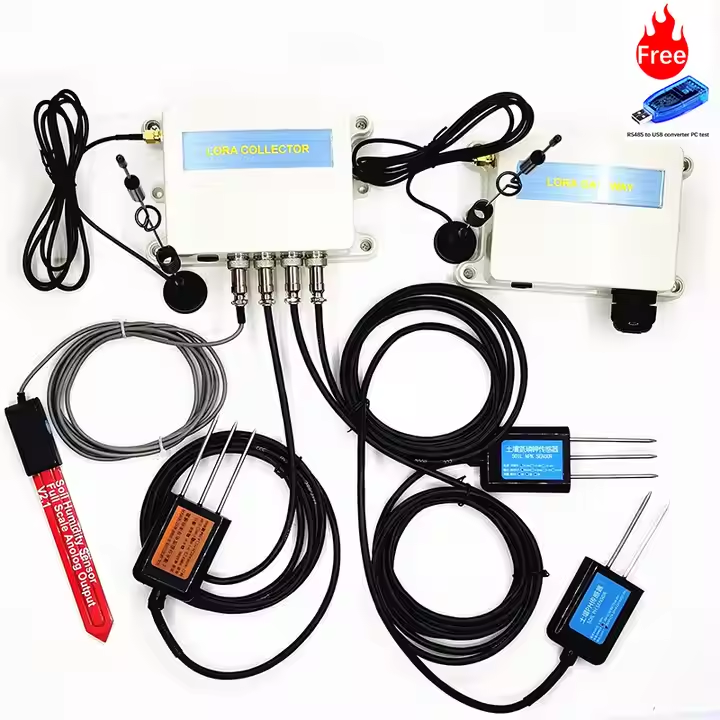ជាមួយនឹងការកើនឡើងនៃឥទ្ធិពលនៃការប្រែប្រួលអាកាសធាតុពិភពលោកលើផលិតកម្មកសិកម្ម កសិករនៅអាហ្រ្វិកខាងត្បូងកំពុងស្វែងរកយ៉ាងសកម្មនូវបច្ចេកវិជ្ជាច្នៃប្រឌិតដើម្បីឆ្លើយតបនឹងបញ្ហាប្រឈម។ ការទទួលយកយ៉ាងទូលំទូលាយនៃបច្ចេកវិទ្យាឧបករណ៍ចាប់សញ្ញាដីកម្រិតខ្ពស់នៅក្នុងផ្នែកជាច្រើននៃអាហ្រ្វិកខាងត្បូងគឺជាជំហានដ៏សំខាន់មួយឆ្ពោះទៅរកកសិកម្មច្បាស់លាស់នៅក្នុងឧស្សាហកម្មកសិកម្មរបស់ប្រទេស។
ការកើនឡើងនៃកសិកម្មច្បាស់លាស់
កសិកម្មច្បាស់លាស់ គឺជាវិធីសាស្រ្តដែលប្រើប្រាស់បច្ចេកវិទ្យាព័ត៌មាន និងការវិភាគទិន្នន័យ ដើម្បីបង្កើនប្រសិទ្ធភាពផលិតកម្មដំណាំ។ តាមរយៈការតាមដានស្ថានភាពដីក្នុងពេលវេលាជាក់ស្តែង កសិករអាចគ្រប់គ្រងវាលស្រែរបស់ពួកគេកាន់តែមានលក្ខណៈវិទ្យាសាស្ត្រ បង្កើនទិន្នផល និងកាត់បន្ថយការខ្ជះខ្ជាយធនធាន។ នាយកដ្ឋានកសិកម្មរបស់ប្រទេសអាហ្រ្វិកខាងត្បូងបានសហការជាមួយក្រុមហ៊ុនបច្ចេកវិទ្យាជាច្រើនដើម្បីដាក់ពង្រាយឧបករណ៍ចាប់សញ្ញាដីរាប់ពាន់នៅលើកសិដ្ឋាននៅទូទាំងប្រទេស។
របៀបដែលឧបករណ៍ចាប់សញ្ញាដីដំណើរការ
ឧបករណ៍ចាប់សញ្ញាទាំងនេះត្រូវបានបង្កប់នៅក្នុងដី ហើយអាចត្រួតពិនិត្យសូចនាករសំខាន់ៗដូចជា សំណើម សីតុណ្ហភាព មាតិកាសារធាតុចិញ្ចឹម និងចរន្តអគ្គិសនីក្នុងពេលវេលាជាក់ស្តែង។ ទិន្នន័យនេះត្រូវបានបញ្ជូនដោយឥតខ្សែទៅកាន់វេទិកាដែលមានមូលដ្ឋានលើពពក ដែលកសិករអាចចូលប្រើវាតាមរយៈស្មាតហ្វូន ឬកុំព្យូទ័ររបស់ពួកគេ និងទទួលបានការណែនាំអំពីកសិកម្មផ្ទាល់ខ្លួន។
ជាឧទាហរណ៍ នៅពេលដែលឧបករណ៍ចាប់សញ្ញារកឃើញថាសំណើមដីទាបជាងកម្រិតជាក់លាក់មួយ ប្រព័ន្ធនឹងជូនដំណឹងដោយស្វ័យប្រវត្តិដល់កសិករឱ្យស្រោចស្រព។ ដូចគ្នានេះដែរ ប្រសិនបើដីមិនមានសារធាតុចិញ្ចឹមគ្រប់គ្រាន់ដូចជា អាសូត ផូស្វ័រ និងប៉ូតាស្យូម ប្រព័ន្ធណែនាំកសិករឱ្យអនុវត្តបរិមាណជីត្រឹមត្រូវ។ វិធីសាស្រ្តគ្រប់គ្រងដ៏ច្បាស់លាស់នេះមិនត្រឹមតែជួយបង្កើនប្រសិទ្ធភាពនៃការលូតលាស់របស់ដំណាំប៉ុណ្ណោះទេ ប៉ុន្តែថែមទាំងកាត់បន្ថយការខ្ជះខ្ជាយទឹក ជី និងធនធានផ្សេងៗទៀតផងដែរ។
ប្រាក់ចំណូលពិតរបស់កសិករ
នៅកសិដ្ឋានមួយក្នុងខេត្ត Eastern Cape របស់អាហ្វ្រិកខាងត្បូង កសិករ John Mbelele បានប្រើឧបករណ៍ចាប់សញ្ញាដីអស់រយៈពេលជាច្រើនខែ។ "ពីមុន យើងត្រូវពឹងផ្អែកលើបទពិសោធន៍ និងវិធីសាស្រ្តបែបបុរាណ ដើម្បីវិនិច្ឆ័យថាពេលណាត្រូវស្រោចស្រព និងដាក់ជី។ ឥឡូវនេះជាមួយនឹងឧបករណ៍ចាប់សញ្ញាទាំងនេះ ខ្ញុំអាចដឹងច្បាស់អំពីស្ថានភាពដី ដែលផ្តល់ឱ្យខ្ញុំនូវទំនុកចិត្តបន្ថែមទៀតលើការរីកលូតលាស់នៃដំណាំរបស់ខ្ញុំ។"
Mbele ក៏បានកត់សម្គាល់ផងដែរថា ដោយប្រើឧបករណ៍ចាប់សញ្ញា កសិដ្ឋានរបស់គាត់ប្រើប្រាស់ទឹកតិចជាង 30 ភាគរយ និងជីតិចជាង 20 ភាគរយ ខណៈពេលដែលបង្កើនទិន្នផលដំណាំ 15 ភាគរយ។ នេះមិនត្រឹមតែកាត់បន្ថយថ្លៃដើមផលិតកម្មប៉ុណ្ណោះទេ ថែមទាំងកាត់បន្ថយផលប៉ះពាល់បរិស្ថានទៀតផង។
ករណីដាក់ពាក្យ
ករណីទី១៖ កសិដ្ឋាន Oasis នៅភាគខាងកើត Cape
ផ្ទៃខាងក្រោយ៖
មានទីតាំងនៅខេត្ត Eastern Cape នៃអាហ្វ្រិកខាងត្បូង កសិដ្ឋាន Oasis គ្របដណ្តប់លើផ្ទៃដីប្រហែល 500 ហិកតា ហើយភាគច្រើនដាំពោត និងសណ្តែក។ ដោយសារតែភ្លៀងធ្លាក់ខុសប្រក្រតីក្នុងតំបន់ក្នុងប៉ុន្មានឆ្នាំថ្មីៗនេះ កសិករ Peter van der Merwe បាននិងកំពុងស្វែងរកមធ្យោបាយដើម្បីធ្វើឱ្យការប្រើប្រាស់ទឹកកាន់តែមានប្រសិទ្ធភាព។
កម្មវិធីឧបករណ៍ចាប់សញ្ញា៖
នៅដើមឆ្នាំ 2024 ពេត្រុសបានដំឡើងឧបករណ៍ចាប់សញ្ញាដីចំនួន 50 នៅលើកសិដ្ឋាន ដែលត្រូវបានចែកចាយពាសពេញដីផ្សេងៗគ្នា ដើម្បីតាមដានសំណើមដី សីតុណ្ហភាព និងបរិមាណសារធាតុចិញ្ចឹមក្នុងពេលវេលាជាក់ស្តែង។ ឧបករណ៍ចាប់សញ្ញានីមួយៗបញ្ជូនទិន្នន័យទៅកាន់វេទិកាពពករៀងរាល់ 15 នាទីម្តង ដែលពេត្រុសអាចមើលក្នុងពេលវេលាជាក់ស្តែងតាមរយៈកម្មវិធីទូរស័ព្ទ។
លទ្ធផលជាក់លាក់៖
1. ប្រព័ន្ធធារាសាស្រ្តច្បាស់លាស់៖
ដោយប្រើទិន្នន័យឧបករណ៍ចាប់សញ្ញា ពេត្រុសបានរកឃើញថាសំណើមដីនៅក្នុងដីឡូតិ៍មួយចំនួនបានថយចុះយ៉ាងខ្លាំងក្នុងរយៈពេលជាក់លាក់មួយ ខណៈពេលដែលកន្លែងផ្សេងទៀតវានៅតែមានស្ថេរភាព។ គាត់បានកែសម្រួលផែនការប្រព័ន្ធធារាសាស្រ្តរបស់គាត់ដោយផ្អែកលើទិន្នន័យនេះ និងបានអនុវត្តយុទ្ធសាស្រ្តធារាសាស្ត្រតាមតំបន់។ ជាលទ្ធផល ការប្រើប្រាស់ទឹកប្រព័ន្ធធារាសាស្រ្តត្រូវបានកាត់បន្ថយប្រហែល 35 ភាគរយ ខណៈដែលទិន្នផលពោត និងសណ្តែកកើនឡើង 10 ភាគរយ និង 8 ភាគរយរៀងគ្នា។
2. បង្កើនប្រសិទ្ធភាពការបង្កកំណើត៖
ឧបករណ៍ចាប់សញ្ញាក៏ត្រួតពិនិត្យមាតិកានៃសារធាតុចិញ្ចឹមដូចជា អាសូត ផូស្វ័រ និងប៉ូតាស្យូមនៅក្នុងដី។ Peter បានកែសម្រួលកាលវិភាគនៃការបង្កកំណើតរបស់គាត់ដោយផ្អែកលើទិន្នន័យនេះ ដើម្បីជៀសវាងការបង្កកំណើតលើសកម្រិត។ ជាលទ្ធផល ការប្រើប្រាស់ជីត្រូវបានកាត់បន្ថយប្រហែល 25 ភាគរយ ខណៈដែលស្ថានភាពអាហារូបត្ថម្ភរបស់ដំណាំមានភាពប្រសើរឡើង។
3. ការព្រមានអំពីសត្វល្អិត៖
ឧបករណ៍ចាប់សញ្ញាក៏បានជួយ Peter រកឃើញសត្វល្អិត និងជំងឺនៅក្នុងដីផងដែរ។ តាមរយៈការវិភាគទិន្នន័យសីតុណ្ហភាព និងសំណើមដី គាត់អាចទស្សន៍ទាយពីការកើតឡើងនៃសត្វល្អិត និងជំងឺ និងចាត់វិធានការបង្ការ ដើម្បីកាត់បន្ថយការប្រើប្រាស់ថ្នាំសម្លាប់សត្វល្អិត។
មតិពី Peter van der Mewe៖
"ដោយប្រើឧបករណ៍ចាប់សញ្ញាដី ខ្ញុំអាចគ្រប់គ្រងកសិដ្ឋានរបស់ខ្ញុំបានតាមបែបវិទ្យាសាស្ត្រ។ ពីមុនខ្ញុំតែងតែព្រួយបារម្ភអំពីប្រព័ន្ធធារាសាស្រ្ត ឬជីជាតិហួសកម្រិត ឥឡូវនេះខ្ញុំអាចធ្វើការសម្រេចចិត្តដោយផ្អែកលើទិន្នន័យជាក់ស្តែង។ វាមិនត្រឹមតែបង្កើនផលិតកម្មប៉ុណ្ណោះទេ ប៉ុន្តែថែមទាំងកាត់បន្ថយផលប៉ះពាល់បរិស្ថានផងដែរ។"
ករណីទី 2៖ “ចម្ការទំពាំងបាយជូរមានពន្លឺថ្ងៃ” នៅ Western Cape
ផ្ទៃខាងក្រោយ៖
មានទីតាំងនៅខេត្ត Western Cape នៃអាហ្វ្រិកខាងត្បូង Sunshine Vineyards ត្រូវបានគេស្គាល់ថាជាអ្នកផលិតស្រាដែលមានគុណភាពខ្ពស់។ ម្ចាស់ចម្ការទំពាំងបាយជូរ Anna du Plessis កំពុងប្រឈមមុខនឹងបញ្ហានៃការថយចុះទិន្នផល និងគុណភាពនៃទំពាំងបាយជូ ដោយសារតែឥទ្ធិពលនៃការប្រែប្រួលអាកាសធាតុលើផលិតកម្ម viticultural ។
កម្មវិធីឧបករណ៍ចាប់សញ្ញា៖
នៅពាក់កណ្តាលឆ្នាំ 2024 អាណាបានដំឡើងឧបករណ៍ចាប់សញ្ញាដីចំនួន 30 នៅក្នុងចំការទំពាំងបាយជូរ ដែលត្រូវបានចែកចាយនៅក្រោមពូជផ្សេងៗគ្នានៃវល្លិដើម្បីតាមដានសំណើមដី សីតុណ្ហភាព និងបរិមាណសារធាតុចិញ្ចឹមក្នុងពេលវេលាជាក់ស្តែង។ Anna ក៏ប្រើឧបករណ៍ចាប់សញ្ញាអាកាសធាតុ ដើម្បីតាមដានទិន្នន័យដូចជា សីតុណ្ហភាពខ្យល់ សំណើម និងល្បឿនខ្យល់។
លទ្ធផលជាក់លាក់៖
1. ការគ្រប់គ្រងល្អ៖
ដោយប្រើទិន្នន័យឧបករណ៍ចាប់សញ្ញា អាណាអាចយល់បានយ៉ាងត្រឹមត្រូវអំពីលក្ខខណ្ឌដីនៅក្រោមដើមទំពាំងបាយជូរនីមួយៗ។ ដោយផ្អែកលើទិន្នន័យទាំងនេះ នាងបានកែសម្រួលផែនការប្រព័ន្ធធារាសាស្រ្ត និងការបង្កកំណើត និងអនុវត្តការគ្រប់គ្រងចម្រាញ់។ ជាលទ្ធផល ទិន្នផល និងគុណភាពនៃទំពាំងបាយជូត្រូវបានកែលម្អយ៉ាងខ្លាំង ក៏ដូចជាគុណភាពនៃស្រាទំពាំងបាយជូរផងដែរ។
2. ការគ្រប់គ្រងធនធានទឹក៖
ឧបករណ៍ចាប់សញ្ញាបានជួយ Anna បង្កើនប្រសិទ្ធភាពការប្រើប្រាស់ទឹករបស់នាង។ នាងបានរកឃើញថាសំណើមដីនៅក្នុងដីមួយចំនួនមានកម្រិតខ្ពស់ពេកក្នុងអំឡុងពេលជាក់លាក់ណាមួយដែលនាំឱ្យខ្វះអុកស៊ីសែននៅក្នុងឫសវល្លិ។ តាមរយៈការកែសម្រួលផែនការប្រព័ន្ធធារាសាស្រ្ត នាងបានជៀសវាងការស្រោចស្រពលើស និងសន្សំសំចៃទឹក។
3. ភាពប្រែប្រួលអាកាសធាតុ៖
ឧបករណ៍ចាប់សញ្ញាអាកាសធាតុជួយ Anna រក្សាបាននូវឥទ្ធិពលនៃការប្រែប្រួលអាកាសធាតុលើចម្ការទំពាំងបាយជូររបស់នាង។ ដោយផ្អែកលើទិន្នន័យសីតុណ្ហភាព និងសំណើម នាងបានកែសម្រួលវិធានការកាត់ចេញ និងការដាក់ស្រមោលរបស់វល្លិ ដើម្បីកែលម្អភាពធន់នឹងអាកាសធាតុរបស់វល្លិ។
មតិរបស់ Anna du Plessis៖
"ដោយប្រើឧបករណ៍ចាប់សញ្ញាដី និងឧបករណ៍ចាប់សញ្ញាអាកាសធាតុ ខ្ញុំអាចគ្រប់គ្រងចំការទំពាំងបាយជូររបស់ខ្ញុំបានប្រសើរជាងមុន។ វាមិនត្រឹមតែធ្វើអោយប្រសើរឡើងនូវទិន្នផល និងគុណភាពនៃទំពាំងបាយជូប៉ុណ្ណោះទេ ប៉ុន្តែវាថែមទាំងផ្តល់ឱ្យខ្ញុំនូវការយល់ដឹងកាន់តែច្រើនអំពីផលប៉ះពាល់នៃការប្រែប្រួលអាកាសធាតុផងដែរ។ វានឹងមានប្រយោជន៍ខ្លាំងណាស់សម្រាប់ផែនការដាំនាពេលអនាគតរបស់ខ្ញុំ។"
ករណីទី 3៖ កសិដ្ឋានប្រមូលផលនៅ KwaZulu-Natal
ផ្ទៃខាងក្រោយ៖
កសិដ្ឋានប្រមូលផលមានទីតាំងនៅខេត្ត KwaZulu-Natal ហើយភាគច្រើនដាំអំពៅ។ ជាមួយនឹងភ្លៀងធ្លាក់ខុសប្រក្រតីនៅក្នុងតំបន់ កសិករ Rashid Patel បាននិងកំពុងស្វែងរកមធ្យោបាយដើម្បីជំរុញផលិតកម្មអំពៅ។
កម្មវិធីឧបករណ៍ចាប់សញ្ញា៖
នៅពាក់កណ្តាលទីពីរនៃឆ្នាំ 2024 លោក Rashid បានដំឡើងឧបករណ៍ចាប់សញ្ញាដីចំនួន 40 នៅលើកសិដ្ឋាន ដែលត្រូវបានចែកចាយពាសពេញដីផ្សេងៗគ្នា ដើម្បីតាមដានសំណើមដី សីតុណ្ហភាព និងបរិមាណសារធាតុចិញ្ចឹមក្នុងពេលវេលាជាក់ស្តែង។ គាត់ក៏បានប្រើប្រាស់ដ្រូន ដើម្បីថតរូបពីលើអាកាស និងតាមដានការលូតលាស់របស់អំពៅផងដែរ។
លទ្ធផលជាក់លាក់៖
1. បង្កើនផលិតកម្ម៖
ដោយប្រើទិន្នន័យឧបករណ៍ចាប់សញ្ញា Rashid អាចយល់បានយ៉ាងត្រឹមត្រូវអំពីស្ថានភាពដីនៃដីនីមួយៗ។ គាត់បានកែសម្រួលផែនការប្រព័ន្ធធារាសាស្រ្ត និងជីជាតិដោយផ្អែកលើទិន្នន័យទាំងនេះ ដោយអនុវត្តយុទ្ធសាស្ត្រកសិកម្មច្បាស់លាស់។ ជាលទ្ធផល ទិន្នផលអំពៅកើនឡើងប្រមាណ ១៥%។
2. រក្សាទុកធនធាន៖
ឧបករណ៍ចាប់សញ្ញាបានជួយ Rashid បង្កើនប្រសិទ្ធភាពការប្រើប្រាស់ទឹក និងជី។ ដោយផ្អែកលើទិន្នន័យសំណើមដី និងបរិមាណសារធាតុចិញ្ចឹម គាត់បានកែសម្រួលផែនការប្រព័ន្ធធារាសាស្រ្ត និងការបង្កកំណើត ដើម្បីជៀសវាងការស្រោចស្រពហួសកម្រិត និងការបង្កកំណើត និងសន្សំធនធាន។
3. ការគ្រប់គ្រងសត្វល្អិត៖
ឧបករណ៍ចាប់សញ្ញាក៏បានជួយ Rashid កំណត់សត្វល្អិត និងជំងឺនៅក្នុងដីផងដែរ។ ដោយផ្អែកលើទិន្នន័យសីតុណ្ហភាព និងសំណើមដី គាត់បានចាត់វិធានការប្រុងប្រយ័ត្ន ដើម្បីកាត់បន្ថយការប្រើប្រាស់ថ្នាំសម្លាប់សត្វល្អិត។
មតិពី Rashid Patel៖
ដោយប្រើឧបករណ៍ចាប់សញ្ញាដី ខ្ញុំអាចគ្រប់គ្រងកសិដ្ឋានរបស់ខ្ញុំបានតាមបែបវិទ្យាសាស្ត្រ។ នេះមិនត្រឹមតែបង្កើនទិន្នផលអំពៅប៉ុណ្ណោះទេ ប៉ុន្តែថែមទាំងកាត់បន្ថយផលប៉ះពាល់បរិស្ថានផងដែរ។ ខ្ញុំគ្រោងនឹងពង្រីកការប្រើប្រាស់ឧបករណ៍ចាប់សញ្ញានៅពេលអនាគត ដើម្បីសម្រេចបាននូវប្រសិទ្ធភាពផលិតកម្មកសិកម្មខ្ពស់»។
រដ្ឋាភិបាល និងក្រុមហ៊ុនបច្ចេកវិទ្យាគាំទ្រ
រដ្ឋាភិបាលអាហ្រ្វិកខាងត្បូងយកចិត្តទុកដាក់យ៉ាងខ្លាំងចំពោះការអភិវឌ្ឍន៍កសិកម្មច្បាស់លាស់ និងផ្តល់នូវការគាំទ្រគោលនយោបាយ និងជំនួយហិរញ្ញវត្ថុមួយចំនួន។ មន្ត្រីរដ្ឋាភិបាលបាននិយាយថា "តាមរយៈការលើកកម្ពស់បច្ចេកវិទ្យាកសិកម្មច្បាស់លាស់ យើងសង្ឃឹមថានឹងធ្វើឱ្យប្រសើរឡើងនូវប្រសិទ្ធភាពផលិតកម្មកសិកម្ម ការពារសន្តិសុខស្បៀងជាតិ និងលើកកម្ពស់ការអភិវឌ្ឍប្រកបដោយចីរភាព"។
ក្រុមហ៊ុនបច្ចេកវិទ្យាជាច្រើនក៏ចូលរួមយ៉ាងសកម្មផងដែរ ដោយផ្តល់ជូននូវឧបករណ៍ចាប់សញ្ញាដីជាច្រើនប្រភេទ និងវេទិកាវិភាគទិន្នន័យ។ ក្រុមហ៊ុនទាំងនេះមិនត្រឹមតែផ្តល់ឧបករណ៍ផ្នែករឹងប៉ុណ្ណោះទេ ប៉ុន្តែថែមទាំងផ្តល់ការបណ្តុះបណ្តាលបច្ចេកទេស និងសេវាកម្មគាំទ្រដល់កសិករ ដើម្បីជួយពួកគេឱ្យប្រើប្រាស់បច្ចេកវិទ្យាថ្មីទាំងនេះកាន់តែប្រសើរឡើង។
ទស្សនវិស័យនាពេលអនាគត
ជាមួយនឹងការរីកចម្រើនជាបន្តបន្ទាប់ និងការពេញនិយមនៃបច្ចេកវិទ្យាឧបករណ៍ចាប់សញ្ញាដី កសិកម្មនៅអាហ្វ្រិកខាងត្បូងនឹងឈានទៅរកយុគសម័យនៃកសិកម្មដ៏ឆ្លាតវៃ និងមានប្រសិទ្ធភាពជាងមុន។ នៅពេលអនាគត ឧបករណ៍ចាប់សញ្ញាទាំងនេះអាចត្រូវបានផ្សំជាមួយយន្តហោះគ្មានមនុស្សបើក គ្រឿងយន្តកសិកម្មស្វ័យប្រវត្តិ និងឧបករណ៍ផ្សេងទៀតដើម្បីបង្កើតប្រព័ន្ធអេកូកសិកម្មដ៏ឆ្លាតវៃពេញលេញមួយ។
លោកបណ្ឌិត John Smith អ្នកជំនាញកសិកម្មអាហ្រ្វិកខាងត្បូងបាននិយាយថា "ឧបករណ៍ចាប់សញ្ញាដីគឺជាផ្នែកមួយដ៏សំខាន់នៃកសិកម្មច្បាស់លាស់។ ជាមួយនឹងឧបករណ៍ចាប់សញ្ញាទាំងនេះ យើងអាចយល់កាន់តែច្បាស់អំពីតម្រូវការរបស់ដី និងដំណាំ ធ្វើឱ្យផលិតកម្មកសិកម្មកាន់តែមានប្រសិទ្ធភាព។ វានឹងមិនត្រឹមតែជួយបង្កើនផលិតកម្មស្បៀងប៉ុណ្ណោះទេ ប៉ុន្តែថែមទាំងកាត់បន្ថយផលប៉ះពាល់បរិស្ថាន និងរួមចំណែកដល់ការអភិវឌ្ឍន៍ប្រកបដោយចីរភាពផងដែរ។"
សេចក្តីសន្និដ្ឋាន
កសិកម្មអាហ្វ្រិកខាងត្បូងកំពុងដំណើរការការផ្លាស់ប្តូរដែលជំរុញដោយបច្ចេកវិទ្យា។ ការអនុវត្តយ៉ាងទូលំទូលាយនៃឧបករណ៍ចាប់សញ្ញាដីមិនត្រឹមតែបង្កើនប្រសិទ្ធភាពផលិតកម្មកសិកម្មប៉ុណ្ណោះទេ ប៉ុន្តែថែមទាំងនាំមកនូវអត្ថប្រយោជន៍សេដ្ឋកិច្ចពិតប្រាកដដល់កសិករផងដែរ។ ជាមួយនឹងការរីកចម្រើនជាបន្តបន្ទាប់នៃបច្ចេកវិទ្យា និងការគាំទ្រគោលនយោបាយ កសិកម្មច្បាស់លាស់នឹងដើរតួនាទីយ៉ាងសំខាន់កាន់តែខ្លាំងឡើងនៅក្នុងអាហ្វ្រិកខាងត្បូង និងទូទាំងពិភពលោក ដោយធ្វើឱ្យមានការរួមចំណែកជាវិជ្ជមានដល់ការសម្រេចបាននូវគោលដៅអភិវឌ្ឍន៍ប្រកបដោយចីរភាព។
ពេលវេលាប្រកាស៖ ថ្ងៃទី ២០ ខែមករា ឆ្នាំ ២០២៥


